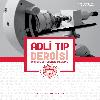Mezar açma sonrası yapılan otopsilerde histopatolojik inceleme sonuçlarının analizi
Analysis of histopathological results of forensic exhumations
___
- 1.Saukko P. Knight B. Knight's Forensic Pathology. Third ed. London: Arnold, 2004:36-41.
- 2.Soysal Z, Eke SM, Çağdır AS. Adli Otopsi, Cilt II. İstanbul : İstanbul Üniversitesi Cerrahpaşa Tıp Fakültesi Yayınları, 1999:587- 599.
- 3.Grellner W, Glenewinkel F, Madea B. Reasons, circumstances and results of repeat forensic medicine autopsy. Arch Kriminol,1998;202:173-178.
- 4.Stachetzki U, Verhoff MA, Ulm K, Muller KM. Morphological findings and medical insurance aspects in 371 exhumations.Patholöge, 2001 ;22:252-258.
- 5.KargerB, Lorin de la Grandmaison G, Bajanowski T, Brinkmann B. Analysis of 155 consecutive forensic exhumation with emphasis on undetected homicides. Int J legal Med, 2004; 118: 90-94.
- 6.Grellner W, Glenewinkel F. Exhumations: synopsis of morphological and toxicological findings in relation to the postmortem interval. Survey on a 20-year period and review of the literature. Forensic Science International, 1997; 90:139-159.
- 7.Demirel B, Akar T, Balseven A.O. Ankara'da 1996-2003 Yılları Arasındaki Feth-i Kabir Olguları. Türkiye Klinikler, Adli Tıp Dergisi, 2006; 3: 53-57.
- 8.Breitmeier D, Graefe-Kirci U, Albrecht K, Weber M, Troger HD, Kleemann WJ. Evaluation of the correlation between time corpses spent in in-ground graves and findings at exhumation. Forensic Sci Int, 2005;154:218-223.
- 9.Tokunaga I, Takeichi S, Yamamoto A, Gotoda M, Maeiwa M. Comparison of Postmortem Autolysis in Cardiac and Skeletal Muscle. J Foren Sci, 1993;38:1187-1193.
- 10.Di Maio DJ, Di Maio VJ. Forensic Pathology. New York: CRC Press, 1993:21-42.
- 11.Althoff H. For which problems can one expect reliable pathomorphological findings after exhumation? Z Rechtsmed, 1974;75:1-20.
- ISSN: 1018-5275
- Yayın Aralığı: 3
- Başlangıç: 1985
- Yayıncı: BAYT Yayıncılık
Spinal cerrahi girişimlere bağlı ortaya çıkan damar yaralanmalarında anestezi uzmanının rolü
Hüseyin ÖZ, Nurşen TURAN, Nur BİRGEN, Ayşegül ERTAN, Murat HANCI
Mezar açma sonrası yapılan otopsilerde histopatolojik inceleme sonuçlarının analizi
Ziya KIR, Ülker Elif AKYILDIZ, Safa ÇELİK, Gökhan ERSOY
Travmalı çocuk hastalara çocuk cerrahisi kliniğinden bakış: Geriye yönelik 10 yıllık çalışma
B. İlker BÜYÜKYAVUZ, M. Sunay YAVUZ, M. Çağrı SAVAŞ, İ. Faruk ÖZGÜNER, S. Ender ÇUBUKÇU
